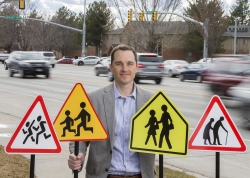Dynamic Road Signs Drawing Attention
PROVO, Utah – Feb 23, 2015 – When a car traveling relatively fast needs to come to an immediate stop, milliseconds matter. Sometimes only a few feet is the difference between life and death.
Researchers from the University of Michigan and BYU have discovered a way to provide a little extra cushion when it comes to near-accidents. Their new study, published in the Journal of Consumer Research, finds that people react significantly faster to warning signs that depict greater movement.
“A sign that evokes more perceived movement increases the observer’s perception of risk, which in turn brings about earlier attention and earlier stopping,” said study co-author Ryan Elder a professor in BYU’s Marriott School of Management. “If you want to grab attention, you need signs that are more dynamic.”
Elder and lead authors Luca Cian and Aradhna Krishna of the University of Michigan pursued the research to explore how static imagery that implies motion can impact behavior. Using driving simulations, click-data heat maps, surveys, reaction time exercises and eye-tracking, the trio found that signs conveying a higher perception of movement lead to quicker action from observers.
In one study experiment, researchers found that participants in a driving simulation reacted an average of 50 milliseconds faster to warning signs with higher dynamism. For a car going 60 mph, that 50 milliseconds translates into an extra 4.4 feet of distance—which can make a difference in close shaves.
In a second experiment, the team used eye-tracking technology to measure how long it takes a person’s eyes to notice a traffic sign. The eye-tracker results showed that signs with higher perceived movement attracted (and maintained) significantly earlier attention than static signs.
“Things that look like they’re going to move get moved in our minds,” Elder said. “Our minds want to continue the motion that is contained within an image—and that has important consequences.”
Elder and his fellow researchers hope the study can ultimately influence policy leading to changes that help reduce accident-related injuries and deaths.
More than 37,000 people are killed every year in the U.S. due to car accidents, with another 2.35 million injured or disabled. The researchers believe increasing the number of dynamic warning signs will help increase the effectiveness of those signs and ultimately lead to fewer deaths.
Media Contact: Todd Hollingshead (801-422-8373)
Writer: Todd Hollingshead




